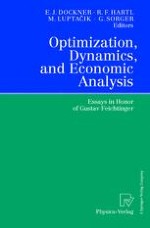2000 | Buch
Optimization, Dynamics, and Economic Analysis
Essays in Honor of Gustav Feichtinger
herausgegeben von: Prof. Dr. Engelbert J. Dockner, Prof. Dr. Richard F. Hartl, Prof. Dr. Mikulas Luptačik, Prof. Dr. Gerhard Sorger
Verlag: Physica-Verlag HD
Enthalten in: Professional Book Archive
